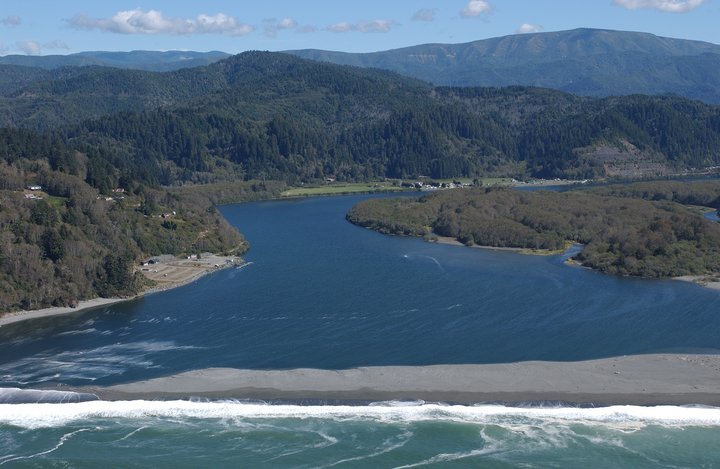
Mouth of the Klamath. Photo: California Coastal Records Project
###
PREVIOUSLY:
###
The decades-long legal battle over Klamath River water will go another round today, as a federal judge in San Francisco will decide whether or not to mandate water releases from upstream dams to prevent disease outbreak among juvenile salmon.
The hearing — which will take place at 2 p.m. in the courtroom of U.S. District Court Judge William Orrick — is a continuation of the same fight last year. In February 2017, Orrick ruled that the Bureau of Reclamation must send pulses of water downstream in the spring to interrupt the lifecycle of the C. shasta parasite, which attacks and kills young salmon.
Members and supporters of the Klamath Water Users Association — an organization representing upstream farmers in Oregon and eastern California — are taking a bus down to San Francisco to attend the hearing. The association holds that the court-mandated water pulses disrupt their planning for the year.
The victors in last year’s case — the Yurok Tribe, the Hoopa Valley Tribe and EarthJustice — will be in attendance as well.
Press release from the Yurok Tribe:
The Yurok Tribe is sending a contingent of Klamath River salmon supporters to sit in on an April 11 hearing to decide whether or not sufficient water will be released this spring and summer to prevent another juvenile fish kill.
“For the Yurok people, there is nothing more important than the Klamath salmon,” said Thomas P. O’Rourke Sr., the Chairman of the Yurok Tribe. “Our fish are an essential part of our way of life and right now, because of the current drought, they are vulnerable to crisis-level disease rates.”
At 2pm on April 11, 2018, William H. Orrick, a judge in the US District Court of Northern California, will hear a motion that was filed by the Klamath Water Users Association and four irrigation districts in an attempt to overturn a March 2017 injunction, which mandated that the Bureau of Reclamation must release more water in the spring and summer to shield baby salmon from a deadly pathogen called Ceratonova Shasta.
The original injunction stems from a lawsuit that the Yurok and Hoopa Valley Tribes, as well as Earth Justice, initiated against the BOR, after the record-low salmon run in 2016. At the time, it was the lowest in history. In 2017, another drought year, the number of spawning salmon was significantly smaller than the previous year,making it the worst on record. The collapse of the Klamath salmon population is largely attributed to elevated disease rates among juvenile fish. This year, the proliferation of this particular disease poses a very real threat to the limited number of coho and Chinook salmon that were born in 2017 and will be migrating to the ocean this spring.
On Wednesday, the Yurok Tribe would like the federal judge to honor the remaining terms of the injunction because these actions are based on the best available science and provide the most certainty that fish will not be infected with C. Shasta. If completed, the stipulations in the court’s order will also reduce the possibility of another year similar to 2017, when the Tribe decided to cancel both the subsistence and commercial fishing seasons to protect the few fish that returned to the river.
Ramping up flows in spring and summer is the only scientifically proven and effective approach to addressing the conditions that lead to large scale juvenile fish die offs. Before infecting salmon, C. Shasta uses as its host a worm that resides the rocks on the river bottom. The high spring flows, called for in the initial injunction, are meant to mimic natural snowmelt on the dam impeded river. The fast moving water transports sediments that scour the river bed and kill the disease organism.
Over the weekend, the BOR carried out one of the provisions included in the injunction, which involved increasing the river’s flows for 72 consecutive hours to achieve the above-listed objective. The second phase of the court order consists of releasing emergency flows, if pathogen levels in the river reach a specific height between spring and summer, when salmon are most susceptible to contracting the disease.
Every time there is a drought, a more common phenomena as of late, disease problems will plague the Klamath fish stocks, until the river’s flows are appropriately managed. The injunction also requires the Yurok Tribe and others to work with the BOR on a long-term plan to reduce pathogen populations and increase the number of juvenile salmon that successfully make it to the ocean. However, the plan won’t be completed in 2019.
“In every decision we make, we consider what it will mean for our fish and for our people several generations into the future. We would like the court and the BOR to take the same approach to prudently managing the Klamath River, the lifeline of the Yurok people,” concluded Chairman O’Rourke.
CLICK TO MANAGE